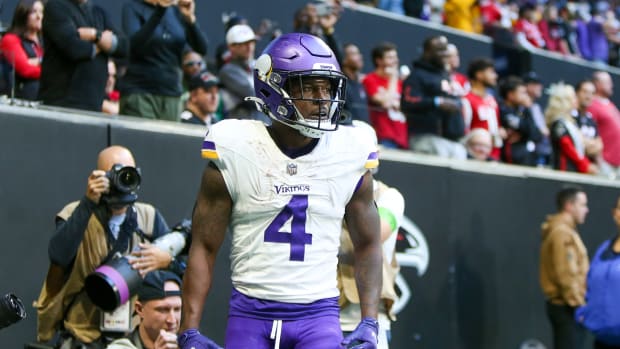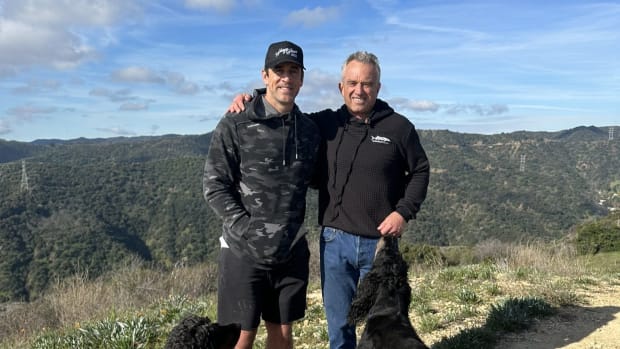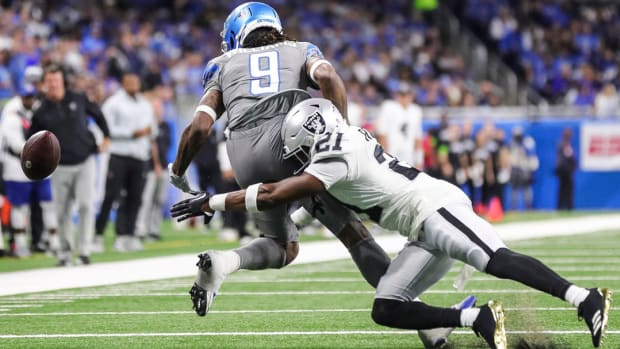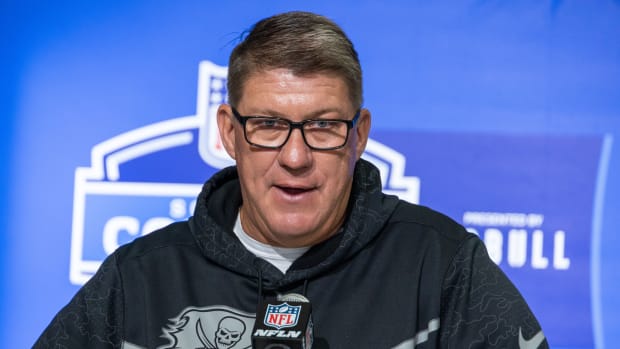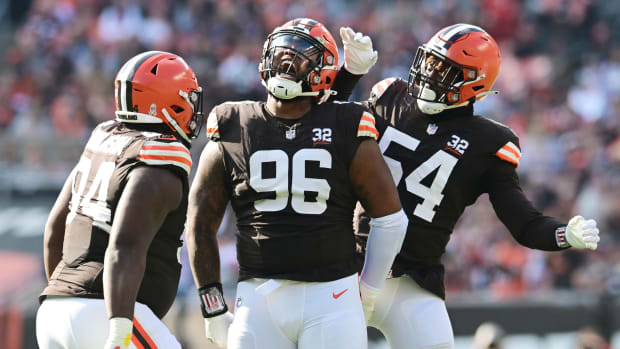The Potential for Playoffs? Raiders’ Del Rio Says Prove It
This time of year is all about potential and promise, and what could be. Jack Del Rio is more worried about what is.
The Raiders coach has heard you. He’s heard me. He knows that, with July not quite out yet, his team is one of those types you see every year—young and bursting with upside, a trendy pick to play into January. But Del Rio isn’t biting.
“I don’t spend a lot of time worrying about potential,” Del Rio said Wednesday morning, after working out his rookies and quarterbacks. “I’ve seen potential come and go. We’re focused on the work and the commitment level and the drive that we’ll need to have in camp. Words like potential, like I said, I’ve seen potential come and go.”
We’re jam-packed this week—checking in with Mike Shanahan, looking at J.J. Watt’s durability, gauging Le’Veon Bell’s future in Pittsburgh, assessing Randy Gregory, figuring out Josh Gordon and more—but it’s the start of camp, and as I hit the road today, now is a good time to look at the big camp questions.
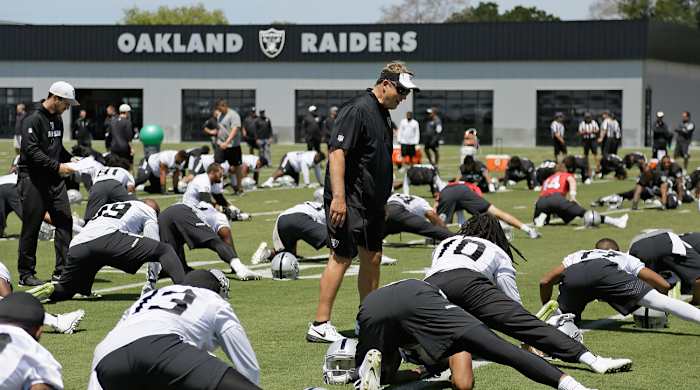
Jack Del Rio is entering his second season as Raiders coach. The team went 7-9 in 2015.
Eric Risberg/AP
Let’s look past the storylines of August and focus on the ones that still will stand up in January. I came up with seven, and the exclusion of your team from this list is not a sign of disrespect ... but please feel free to take it like that.
1. Can the Broncos avoid a heavy a Super Bowl hangover? Denver will become the first team to go into a title defense while undergoing a quarterback change since the 2001 Ravens replaced Trent Dilfer with Elvis Grbac. Those Ravens made the playoffs, but Grbac posted a 15-18 TD-INT ratio and cut him after the season. If that’s not enough, Denver also weathered storms involving Von Miller and AqibTalib.
2. How will the Seahawks offense change with Marshawn Lynch gone?Pete Carroll is loathe to discuss offensive “identity.” But for a team whose edge was fueled for five years by Lynch’s bruising style, it’s undeniable there’s a void. The good news is Russell Wilson made a leap last year when Lynch went down, and Thomas Rawls and rookies Alex Collins and C.J. Prosise have ability.
• SCOUTING SEATTLE: 10 things Andy Benoit thinks about the Seahawks
3. How does the Tom Brady suspension affect the Patriots’ season? Two years ago, the Patriots couldn’t have looked much worse in starting 2-2, and they wound up winning a championship. So even a bad September is unlikely to sink New England. Still, the absence of Brady—for my money, the greatest player ever to play the position—can’t be ignored. Is it possible the other 10 guys in the huddle are better for the experience?
4. Is Ezekiel Elliott the Cowboys’ ticket back to 12 wins? The Dallas brass thinks so, and the reason why isn’t just Elliott’s ability. It’s what having a strong running game could do to preserve the quarterback’s health, accentuate the offensive line’s strength, and mitigate the defense’s deficiencies.
5. Can the Colts keep Andrew Luck in one piece? This is simple. The offensive line needs to be better. Adding Ryan Kelly at center should help. But the fact is Luck was taking too many hits before the dam broke in 2015. If the Colts can change that, Luck can unlock the potential of a talented young group of receivers, and Indy’s dynamic changes.
6. Is Brock Osweiler the answer in Houston?The Texans don’t need Osweiler to suddenly morph into the second coming of Dan Marino. There’s enough talent on defense, and around Osweiler on offense, where he can simply come in and build on how he grew as a Bronco. This team started four different quarterbacks last season and made the playoffs.
7. Will the Redskins’ young core take the next step?Forget for a moment the Kirk Cousins saga and look at Washington’s past two draft classes. The 2015 group, led by Brandon Scherff, Preston Smith and Matt Jones, is loaded. The 2016 group has made a good early impression. It’s all proof that the hire of Scot McCloughan 18 months ago has already paid dividends. The next step for that core should be interesting.
But to me, you can have all of those, and I’ll take the story of where the Raiders are right now, five years after the passing of the iconic Al Davis.
* * *
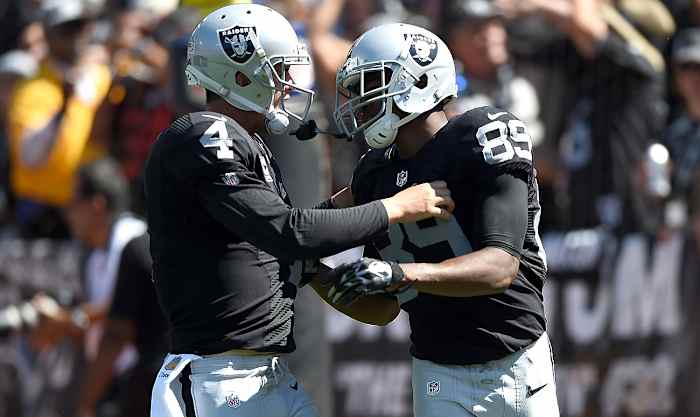
Derek Carr and Amari Cooper give the Raiders the best 25-and-under QB-WR pairing in the NFL.
Thearon W. Henderson/Getty Images
It’s pretty amazing, considering where Oakland has been over the past decade-plus, which is basically nowhere. Absent a brief uptick under Hue Jackson, the rebuild has been perpetual, with the team stuck in a second-class facility and relegated as the Bay Area’s second-class team.
No more. Now, they've got as talented a young core as there is in the NFL. No one has a 25-and-under trio like Derek Carr, Amari Cooper and Khalil Mack, and this offseason that was affirmed with free agents choosing to come to the East Bay. Off the field, they could be the league’s second team to return to Los Angeles, or its first in Las Vegas.
So with all that, the Raiders report to Napa. Again, Del Rio knows, and when you talk to him, he guards against all the potential talk.
• LAS VEGAS RAIDERS? Momentum builds for possible move to Sin City
“That goes into all the noise, that has nothing to do with executing on third-and-8,” Del Rio says. “All those words mean nothing, so I don’t spend any time on it. What matters is doing the work.”
The Raiders’ beleaguered fan base finally feels like it’s Christmas in July, and here comes Del Rio as the Grinch. But get him talking about the guys, rather than the expectations, and it’s safe to hang the stockings.
Just take his assessment of the spring. Del Rio loves the way Seahawks transplant Bruce Irvin came in with an attitude and edge, and sees a rapport developing in the way Irvin and Mack challenge each other. Del Rio is impressed with the maturity Sean Smith and Reggie Nelson have brought to the back end of the defense. He sees Kelechi Osemele as a road-grading beacon for Oakland’s emphasis on improvement in the run game.
And best of all, he’s seeing more steps from Carr, who’s getting his second year in a system for his first time as a pro.
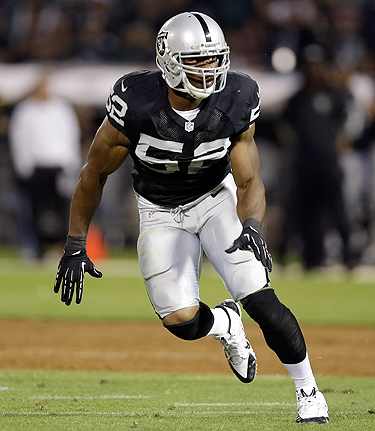
Khalil Mack made the leap from four sacks as a rookie in 2014 to 15 last season.
Ezra Shaw/Getty Images
“The young guys that are here—the Dereks, the Khalils, the Amaris—they’re workers and they’re great teammates,” Del Rio says. “And they were here the whole spring, so everyone was here the whole spring. And then the new guys, the way they integrated in, there was instant chemistry, they were accepted. You could see the closeness of the group.
“One of the things you hope for is that guys get along and respect each other. We felt like with the pieces we added, it did all fit together.”
That’s nice, of course, but will only get the Raiders so far.
Del Rio likes a lot of the signs he’s seen, yes. He’ll point to last year’s Week 2 win over Baltimore, right after the season-opening blowout loss to Cincinnati, as one turning point for his young core. He’ll give you the Week 15 win over the champion Broncos, during which the defense kept the team in it through an ugly first half, as another.
But there’s a difference between that—flashes that show (that word again) potential—and being a playoff team, too. And that’s the jump Del Rio is looking to make now.
“I think it’s just believing you can win, and you only gain that confidence through work,” he says. “Then it’s a matter of flourishing in those situations. All of these games are one-score games. It comes down to who makes plays, executes and performs in those situations. Those are the things that separate the 12-4 teams and the teams that are 7-9 or 4-12. You’ve got to be good enough to be in games. Then, there’s a point where you understand how to win them.”
Without saying it in so many words, Del Rio is explaining the difference between having potential, and delivering on it. And that pretty much explains where the Raiders are now, and where they’re trying to get in 2016.
* * *
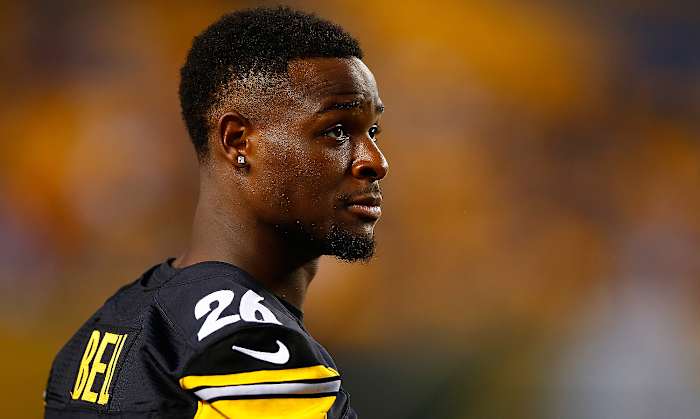
Le'Veon Bell’s contract with the Steelers expires following the 2016 season.
Jared Wickerham/Getty Images
FOUR DOWNS
1. Mike Shanahan back coaching. Last month, Mike Shanahan was back working a meeting room. But this time, it was with much younger players than he’s accustomed. One of Shanahan’s old Redskin assistants, Richmond Flowers, launched “The QB Masters Project” this summer at a plush new facility in Thousand Oaks, Calif. The idea is really simple. When Flowers became a coach, he figured out how little he knew as a player, and wondered if he’d have lasted longer on the field with that knowledge. So now, he wants to give young quarterbacks the kind of training that NFL coaches get, and create an environment different than so many other camps that prep stars attend, centered on getting noticed and recruited. (The rules are loosened considerably because Flowers didn’t pursue college coaches to lead the camp). Shanahan was quickly drawn to the invitational event, and joined Trent Dilfer in headlining the event, with NFL assistants (like Washington’s Sean McVay) and former pro quarterbacks (like Richard Bartel and Kevin O’Connell) staffing it. “Richmond did a tremendous job,” Shanahan said. “The kids really want to learn and they’re trying to grasp as much as they can. I didn’t see a big difference between these guys and college guys or pros there; they wanted to get better and ate everything up. … You get them in the classroom, spending 6-8 hours a day talking ball, and the kids keep doing that, it’ll give them the upperhand.” As for Shanahan himself, he says he’s “retired” but won’t rule out the idea of a comeback at some point. He’s interviewed for jobs in Buffalo, Oakland and San Francisco (twice) over the past two offseasons. At this point, his interest in returning to the sideline has waned a little, but he’s considered the idea of working in a front-office or consultant role for a (properly-aligned) team that wants to draw knowledge from a man who went to 10 conference title games and six Super Bowls in 29 NFL seasons. “People always ask if I’m interested,” Shanahan told me. “I’m always interested, but it has to be a place where I know you can win a Super Bowl.”
2. J.J. Watt’s workload—and a backstory. Either the Texans’ three-time Defensive Player of the Year will return from major back surgery in less than eight weeks or he’ll miss his first game as a pro. And if you look closer, and consider the stuff he’s fought through, it really is amazing he’s made it this far. Per Football Outsiders, Watt has ranked top five among defensive linemen in percentage of snaps played in each of the past four years (96.2% in 2015; 93% in 2014; 94.1% in 2013; 88.0% in 2012), and has been on the field for 3,951 of the team’s 4,262 regular-season snaps over that period (92.7 percent). For a guy who’s on the interior and being blocked in close quarters (often by more than one man) a lot, that’s staggering. Now, coaches often say the greatest ability is availability, which necessitates durability. And in that regard, the backstory of Watt’s draft day can actually lead you here. “Let me tell you—there’s been a lot of conversation about who made that pick, and it’s funny because I’d tell you the most important person, the guy who played the biggest role, was our team doctor, Jim Muntz,” GM Rick Smith explained to me. “We’d targeted another player and, two days before the draft, Jim got some information and he didn’t feel comfortable, so he called me. And I trust Jim and our medical process, so once we got that information, we had to adjust. He was as important as anyone. I can’t say for sure, but I think we would’ve gone with the other guy.” Smith wouldn’t say who the player was (you can take your own guesses there), but the story illustrates how important the medical is to each evaluation—and how there is a way to make an educated guess on how well a player will hold up. The Texans bet Watt would hold up. He has, while carrying a very heavy workload. “The major lesson I take is to trust the process,” Smith says now. “We had a process in place. … You’re told by the medical guys that you can’t take a guy, you have to trust the process.” One more wrinkle to that 2011 story—Smith added that he was close to a deal with the Niners to move from No. 11 to 7. It was contingent on Patrick Peterson making it there. “I’d fallen in love with him,” Smith says. Peterson didn’t get there. The rest is history.
3. Bell tolling for last time in Pittsburgh?Coming off a serious injury and now facing the prospect of starting a second straight season suspended, Le’Veon Bell’s future in Pittsburgh is suddenly pretty murky. At the very least, the idea of Bell getting $15 million per season (Adrian Peterson is the only back making over $10 million per) seems laughable now. If you’re the Steelers, would you rather invest in Bell, a great player with injury and off-field problems, or roll the dice on drafting a back in 2017? And what if I told you the ’17 tailback class has a chance to be the best in more than a decade? You can start with LSU junior Leonard Fournette, who may be a better prospect than Todd Gurley was pre-injury, and keep going with Florida State junior Dalvin Cook, and take it from there. “I mean, Fournette is a motherf-----,” said one AFC college scouting director. “He’s a bad dude. Big, fast, nimble, runs with aggression. You watch a (Adrian) Peterson and see Gurley and talk about how rare they are, and two years later here comes another one. … And Cook is extremely dynamic. Those two are really good. It’s a (Ricky) Williams/(Edgerrin) James type of year, and the other kids are good too. You’re seeing a rebirth of the position.” Stanford’s Christian McCaffrey could be a third first-rounder in the group. If Georgia’s Nick Chubb gets healthy, he could be fourth. And guys like Oregon’s Royce Freeman and Tennessee’s Jalen Hurd will likely bring more depth to the class. If you add it up, Pittsburgh now can sit tight with Bell and have a heck of a safety net for the future in the group coming out.
4. Gregory playing down to expectations. Randy Gregory was considered a Top 5 talent going into the 2015 draft cycle, and fell all the way to the bottom of the second round because teams felt the stud pass-rusher had mental-health issues that could prevent him from ever cleaning up his drug problem. And that was even before he failed the combine drug test, and well before failed 2016 tests that now have him facing suspensions. Before Gregory was drafted, one personnel exec I trust implicitly described the prospect of taking him like this: “It all depends on the organization, and what they have in place for him. There are quite a few players that have issues. It’s where you place football character over the things he can’t control. That’s the big thing to me.” In other words, the question was whether Gregory would eventually want to become a great player so badly that he’d find a way to manage very-hard-to-manage issues, and the answer to that (thus far) has been no. As for the question of organizational support, this cuts both ways in Dallas. The team got Gregory treatment last year, and there’s a feeling inside the building that his marijuana habit is more to self-medicate than it is to get high. Also, much like they have in the past with Dez Bryant, the club kept very close tabs on Gregory, making sure constantly that he was where he needed to be. The flip side is something the Cowboys have acknowledged—it certainly didn’t help having Greg Hardy in the same position room, giving the then-rookie an example in the next chair over that rules didn’t need to be followed. What’s next? Maybe Gregory makes it back. Maybe he vanishes, like Justin Blackmon did. What’s certain is there are bigger issues he has to resolve first.
* * *
THREE CHECKDOWNS
• Jimmy Garoppolo’s march to his first NFL start begins in earnest Thursday as the Patriots open camp. Meanwhile, the man he’ll be temporarily replacing—Tom Brady—also is making preparations for September. My understanding is that Adam Dedeaux, who recently bought out Tom House’s quarterback school in Southern California, is tentatively set to be with Brady in Massachusetts for a good chunk of his four-game suspension.
• The Peyton Manning resolution was a big win-win for both the all-time great and the NFL. Manning clears his name—and the way to eventually reenter the league as a team executive. The league, meanwhile, gets a shining example of how a player who cooperates with an investigation is treated. Remember, after the Ray Rice debacle, the league pledged to lean less on law enforcement, and it’s a challenge to conduct investigations without subpoena power. The Manning example could make it easier.
• There’s no question that the under-30 retirement phenomenon merits the attention of the football-watching public. But don’t be fooled—a good number aren’t exactly voluntary. After covering the NFL for 12 years, the thing I tell people I know now that I didn’t notice as a fan is how quickly the league discards of players. And that’s in part because the line between being a really good player and one not worthy of a job is pretty thin.
* * *
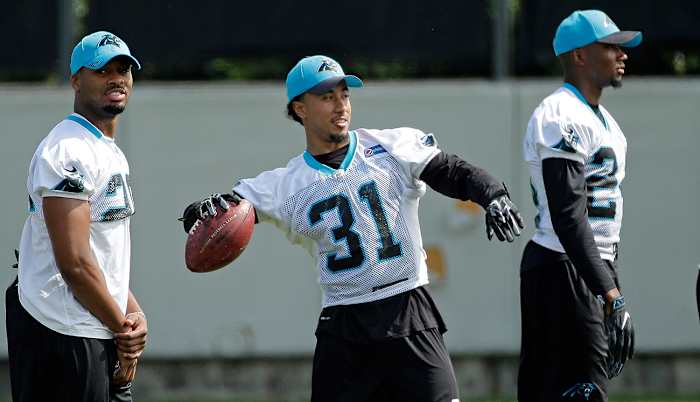
The Panthers’ three rookie cornerbacks, from left: Daryl Worley, Zack Sanchez and James Bradberry.
Chuck Burton/AP
TWO PLAYERS WORTH WATCHING AT CAMP
Panthers CB James Bradberry.OK, this isn’t just about Carolina’s second-round pick; it’s also about third-round pick Daryl Worley, and fifth-round pick Zack Sanchez. Last year, Josh Norman started 16 games at corner for Carolina, Charles Tillman started 12, and Bene Benwikere started four4. Only Benwikere is back, and he’s coming off a broken leg and starting the season on PUP. So one way or another, the Panthers will need a rookie to grow up quick. The spotlight will be on Bradberry, though evaluators aren’t convinced he’s the best of the Panthers rookies. “Maybe you get (Bradberry) in sub packages,” said an AFC college scouting director, “but not as a full-time starter. He’s a solid player, and if they had an established No.1, they could hide him. But they don’t.” So I asked if any of the three can be expected to play a major role right away. He responded, “Worley can. He’s better (than Bradberry) and more ready.” An AFC area scout assigned to the south echoed the concern on the Samford-produced Bradberry, saying, “I think he’s gonna take some time. He’s raw and a little tight hipped. Good ball skills. I think he’s a solid backup, borderline starter that may end up seeing time at safety.” That’s probably not what people in Carolina want to hear, of course. But there’s plenty of reason to trust GM Dave Gettleman, and a good parallel can be drawn here in how the Panthers made up for the loss of Steve Smith over the past two seasons. Receiver hasn’t exactly been a major strength since the Panthers let Smith walk, but they’ve been resourceful at the position and have gotten by just fine. And having the front seven that Carolina has doesn’t certainly won’t hurt.
Bills OLB Jerry Hughes.Last year represented a first for Rex Ryan—a defensive group got substantially worse on his watch. The top-ranked defense of 2014 plummeted to 19th, and the change you’d expect came. Ill-fitted edge rusher Mario Williams is gone, and the Bills drafted Shaq Lawson to replace him. The problem, of course, is that Lawson came into the league with a serious labrum issue, needed surgery soon after to repair it, and that left Ryan talking about the heavyweight champion of the AFC East, IK Enemkpali, as a potential piece to replace Williams on the field until Lawson is ready. That leaves Hughes, who’s undergone a 25-sack renaissance in his three years in Buffalo after being labeled a draft bust in Indy, as the real and possibly only threat bringing pressure off the edge. Asked whether the upheaval will affect Hughes, one AFC personnel exec said, “He’s athletic, so they’ll move him around, and he should be fine because their scheme is so blitz heavy.” The Bills are certainly counting on Hughes to be OK.
* * *
EXTRA POINT
If the Browns want to know how to handle newly reinstated receiver Josh Gordon, they could do worse than dust off their 2013 blueprint.
That was the season that Gordon went off on the field—87 catches, 1,646 yards and nine touchdowns in just 14 games. But just as notably, it was also the only calendar year this decade during which the star-crossed stud was able to keep his nose clean.
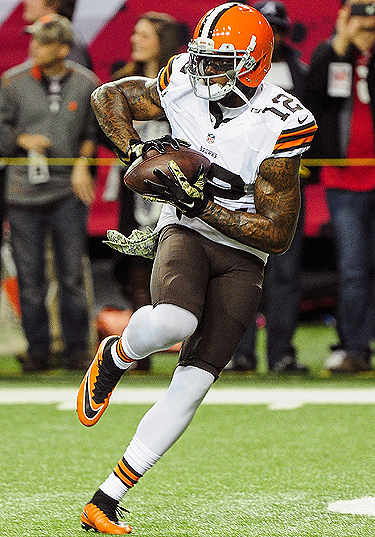
Josh Gordon missed the entire 2015 season and will miss the first four games of 2016 as well.
Scott Cunningham/Getty Images
The story of how the previous regime pulled it off starts with then-CEO Joe Banner and coach Rob Chudzinski recognizing early that there was a small group of problem guys on the roster who needed help, and then seeing that the team would need help in dealing with them.
The Browns conducted a search that led to the hire of performance psychologist James Bell, who’d been working with cricket players in England, and paired him with Cleveland Clinic psychiatrist Mayur Pandya. Those two created a general program and individual plans for players like Gordon, T.J. Ward and Phil Taylor.
With Gordon in particular, establishing trust was important, and not easy. Both Bell and Pandya were able to do it. The coaches got there, too.
Chudzinski, then-offensive coordinator Norv Turner and then-receivers coach Scott Turner each spent considerable time with the introverted Gordon, as did head athletic trainer Joe Sheehan, who worked closely with Pandya. And the key for them, as I understand it, was being crystal clear with him across the board, because the bookending piece to gaining his trust in 2013 was creating accountability.
It didn’t mean yelling. In fact, that could be counterproductive, because of Gordon’s insecurity. But it might mean calling him in the morning to make sure he was on his way to work, or staying on him about an assignment.
As the Browns saw it, Gordon had positive and negative influences in his life, and they did their best to try to steer him to the positive people (one such person was a brother of Gordon’s who was living in California) and away from the negative.
Without question, it took a Herculean effort to keep Gordon in line—and despite all of this, the team was veryclose to dealing him to San Francisco that October.
But in the end, the results made it worth it. And the Browns felt good about it for reasons beyond just all those unimaginable statistics.
“I think he’s intelligent and, deep down, a good person,” said one former Browns staffer. “He does care about people.”
Most of the organization has been overhauled in the two-plus years since, but EVP of football operations Sashi Brown and owner Jimmy Haslam were there. So they have some background on what will—and won’t—work with Gordon.
But whether they can pull off what the organization did three seasons ago remains, very much, an open question.
• Question or comment? Email us at talkback@themmqb.com.
































